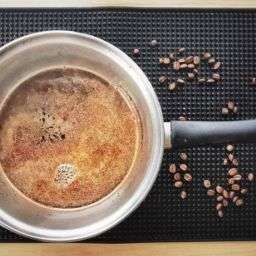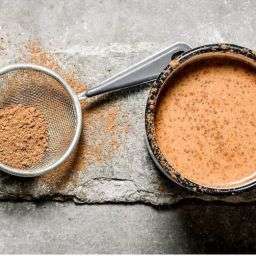
Cuban coffee, affectionately known as cafecito, is not just a drink; it’s a cultural emblem. Steeped in tradition, this rich, intensely sweet coffee captures the essence of Cuban hospitality and warmth. Unlike your average cup of joe, cafecito boasts a unique preparation method that involves a Moka pot and a significant amount of sugar, creating its signature thick, foamy layer known as ‘espuma’. This article will guide you through the delightful process of using a Cuban coffee maker to brew the perfect cup of this beloved beverage, allowing you to bring a piece of Cuban culture into your home.
Key Takeaways
- Moka Pot Mastery: The cornerstone of brewing authentic Cuban coffee, the Moka pot, is essential for achieving that concentrated espresso-like base.
- Sugar’s Sweet Role: Sugar isn’t just an additive; it’s a crucial component that interacts with the coffee to create the iconic creamy foam.
- Variety is the Spice: From the robust solo espresso to the creamy café con leche, Cuban coffee offers variations for every palate.
- Brewing Beyond Borders: Don’t have a Moka pot? No worries! You can still get close to the traditional taste with a few tweaks to your regular coffee maker.
- Caring for Your Coffee Maker: Regular maintenance ensures your Moka pot continues to produce the best cafecito every time.
Understanding Cuban Coffee
The story of Cuban coffee is as rich as its flavor. Originating from the island’s first coffee plantation in 1748, Cuban coffee quickly became a staple, not only for its stimulating effects but also for its role in social and cultural gatherings. At its heart are three essential elements: the Moka pot, for brewing; sugar, for creating the distinctive sweet foam; and, of course, the coffee itself, preferably a strong, dark roast that forms the soul of the drink. Together, they create a coffee experience that is deeply embedded in Cuban culture and enjoyed by people around the world.
How to Use a Cuban Coffee Maker: Step by Step
Brewing Cuban coffee, or cafecito, with a Moka pot is an art that promises a journey into the rich coffee culture of Cuba. Let’s dive into the steps to make your own cafecito, ensuring each sip is as authentic and delightful as intended.
Step 1: The Moka Pot – The iconic Moka pot consists of three parts: the bottom chamber for water, the basket for coffee, and the top chamber where your coffee will end up. Begin by filling the bottom chamber with water up to the safety valve.
Step 2: The Coffee – Add finely ground coffee to the basket. Cuban coffee traditionally uses a dark roast, finely ground to ensure a strong and rich flavor. Do not press down the coffee; just fill it up to the brim and level it gently.
Step 3: The Sugar – Before you put the Moka pot on the stove, take a moment to prepare the sugar. The secret to Cuban coffee’s unique sweetness is the espumita, a thick foam made by whipping sugar with a little of the first coffee that comes out of the pot. Start with about 2 tablespoons of sugar in a cup for every cup of coffee you’re making.
Step 4: Mixing – When the coffee starts brewing, add a few drops of the very first coffee to the sugar. This coffee is the most concentrated and will help create the perfect espumita. Whip the sugar and coffee vigorously until it becomes a light, creamy foam.
Step 5: Heat – Place your Moka pot on medium heat. It’s crucial not to rush this process; the coffee needs to brew slowly to extract all the flavors fully.
Step 6: The Brew – Once the coffee starts to fill the top chamber, listen for a hissing sound. This means your coffee is done. Don’t let it sit on the heat too long, or it can become bitter.
Serving Suggestions: How to Serve Cuban Coffee Authentically
Step 7: Combining – Pour the brewed coffee over the espumita and stir gently. This integrates the foam with the coffee, ensuring each cup has a bit of that sweet, creamy foam.
Step 8: The Serve – Cuban coffee is traditionally served in small cups, similar to espresso but with a heartier, sweeter flavor profile. Pour the coffee into these cups and share the experience. Cuban coffee is not just about the taste; it’s about the moment it creates, shared between friends or a moment of solitary enjoyment.
Using a Regular Coffee Maker
You can still enjoy a cup of Cuban coffee even if you don’t have a Moka pot. Start with a fine grind similar to espresso, and use a bit more coffee than usual to achieve the strong flavor. For the espumita, whip sugar with a few drops of coffee in a separate bowl until creamy, then mix it into your brew. It’s a simple tweak to your regular brewing method that brings you closer to authentic Cuban coffee.
Popular Variations
- Café con Leche: Essentially Cuban coffee served with warm, steamed milk, creating a comforting and creamy drink.
- Cortadito: Offers the perfect balance with a splash of steamed milk, softening the coffee’s strong flavor without overpowering it.
- Explore other variations like adding condensed milk for sweetness or making an iced version for hot days.
FAQs
Can I make Cuban coffee without a Moka pot?
Yes, with adjustments in brewing method and sugar mixing, you can create a version of Cuban coffee with a regular coffee maker.
What are some common variations of Cuban coffee?
Apart from the traditional cafecito, variations include Café con Leche, Cortadito, and using condensed milk or making it iced.
How do I clean and maintain my Cuban coffee maker?
For the Moka pot, regular cleaning after each use is essential. Occasionally, a deeper clean to remove coffee oil residue ensures longevity and taste preservation.
Is it possible to make a decaf version of Cuban coffee?
Absolutely! You can enjoy the rich flavors of Cuban coffee without the caffeine by using decaf coffee beans.
Final Thoughts
Embracing the Cuban coffee-making ritual is about more than just the brew; it’s about experiencing a piece of Cuban culture right in your kitchen. Whether you’re a purist using a Moka pot or adapting with a regular coffee maker, the joy of Cuban coffee lies in its rich flavor and the moments it creates. Experiment with variations, find your perfect cup, and let each sip transport you to the vibrant streets of Havana.








